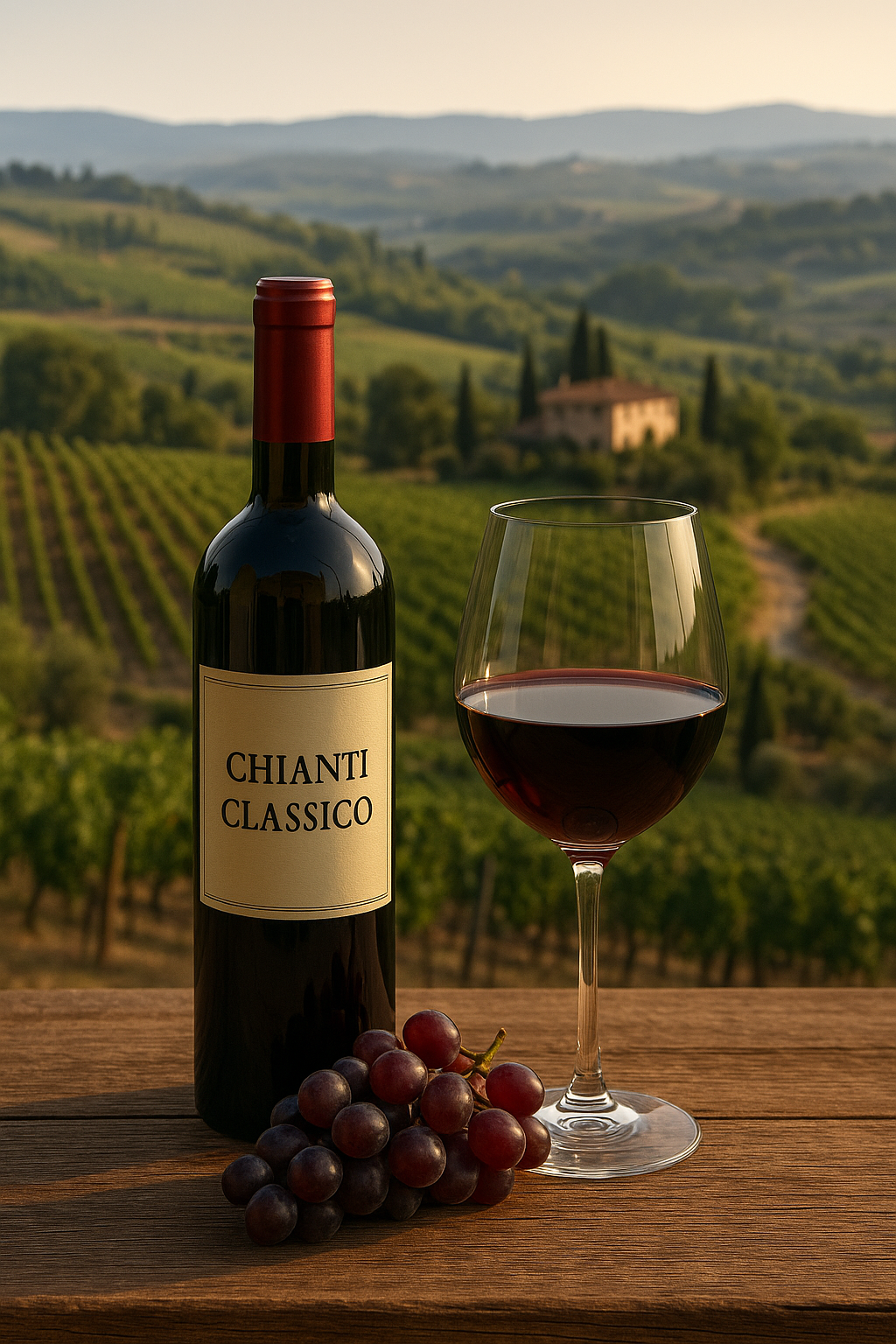Introduction
Chianti Classico is one of the most iconic wines of Tuscany and Italy. It is loved worldwide not only for its unique taste but also for its deep connection with the local land and culture. This wine comes from a well-defined area between Florence and Siena. Here, rolling hills, historic villages, and centuries-old vineyards create a product that truly expresses this corner of Tuscany. In this article, you will discover its production area, organoleptic characteristics, traditions, and tips to enjoy Chianti Classico at its best.
The Chianti Classico Region: A Unique Terroir
The Chianti Classico area is much more than a simple geographical zone. Covering about 70,000 hectares, its soil is a mosaic of galestro (clay shale), alberese (limestone), and clay. These elements give the wines a rare mineral complexity. Moreover, the altitude, between 250 and 600 meters, offers ideal climatic conditions. Temperature variations between day and night favor the slow ripening of the grapes. As a result, aromas and acidity develop in perfect balance.
Vineyards often grow on slopes facing south or southwest to capture more sunlight. Many of these vines are centuries old and produce concentrated, complex grapes. The landscape also features ancient castles, Renaissance villas, and small villages such as Greve in Chianti, Radda, and Castellina. Therefore, visiting the region is a journey through history, culture, and nature.
History of Chianti Classico: Tradition and Innovation
Chianti Classico is one of Italy’s oldest wines, with origins dating back to the 14th century. In 1716, Grand Duke Cosimo III de’ Medici defined the production area, making it one of the first controlled denominations in the world. Over the centuries, winemakers have preserved this legacy. However, in recent decades, they have also embraced innovation. Modern techniques, vineyard care, and sustainable practices now complement tradition. Consequently, Chianti Classico today competes on the international stage, also thanks to its excellent aging potential.
Wine Characteristics: What Makes Chianti Classico Unique
Chianti Classico must contain at least 80% Sangiovese grapes. This variety gives the wine its aromatic profile and tannic structure. The remaining 20% may include native grapes such as Canaiolo and Colorino or international varieties like Cabernet Sauvignon and Merlot. This blend allows producers to create wines with the perfect balance of freshness, tannins, and aromas.
In the glass, Chianti Classico shines with a bright ruby red color that turns garnet as it ages. The bouquet is intense and complex: red fruits, floral notes of violet, and spicy hints blend with earthy or tobacco notes in mature versions. On the palate, lively acidity and elegant tannins make it a versatile wine. It pairs beautifully with rich dishes and is also enjoyable on its own.
Differences Between Chianti and Chianti Classico: The Black Rooster Selection
Chianti DOC covers a large area and includes several subzones. Chianti Classico DOCG, by contrast, comes from a smaller and strictly regulated area. The famous Black Rooster (Gallo Nero) on the label marks this distinction. To use the emblem, producers must respect strict rules on yields, grape composition, and aging. Therefore, Chianti Classico is generally more structured, complex, and long-lasting than generic Chianti DOC.
The Black Rooster: A Symbol of a Millenary History
The Black Rooster has ancient origins. It was the emblem of the League of Chianti, a medieval alliance between Florence and Siena. Today it guarantees the quality and authenticity of the wine. Seeing the Black Rooster on the label means choosing a product that follows strict production standards.
Food Pairings for an Authentic Experience
Chianti Classico pairs perfectly with many Tuscan dishes. It is ideal with Florentine steak, pici all’aglione, wild boar or hare ragù, and Tuscan liver crostini. Moreover, hearty soups like ribollita also match beautifully. Its acidity and tannins cleanse the palate, balancing intense flavors. Aged cheeses such as Pecorino Toscano and Parmigiano Reggiano are also excellent companions.
Chianti Classico in the Anglo-Saxon World: An Italian Symbol of Quality
The Anglo-Saxon market—especially the United Kingdom, United States, Canada, and Australia—has a strong appreciation for Chianti Classico. Here, it represents Italian lifestyle and gastronomy. Riserva and Gran Selezione versions, in particular, are valued for their complexity and aging potential. As a result, tasting Chianti Classico abroad often becomes a journey into authentic Italian flavors.
Experience Chianti Classico with TuscanMansions.com
For an immersive experience, stay in an exclusive villa among the Chianti hills. TuscanMansions.com offers a selection of luxury properties in this region. Many villas are surrounded by vineyards and offer private tastings at local wineries. In addition, guests can join food and wine events, cooking classes, and tours of charming Tuscan villages. Therefore, staying here means living the true heart of Chianti Classico.
Conclusions
Chianti Classico is more than a wine. It is a journey through Tuscany, its history, and its traditions. Strict production rules, a unique terroir, and a balanced taste make it an excellent choice for wine lovers. Choosing a bottle with the Black Rooster means bringing to the table the authentic essence of Tuscany.
